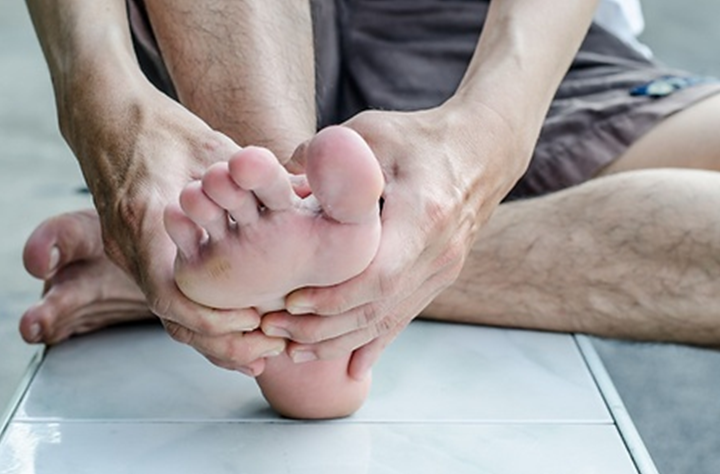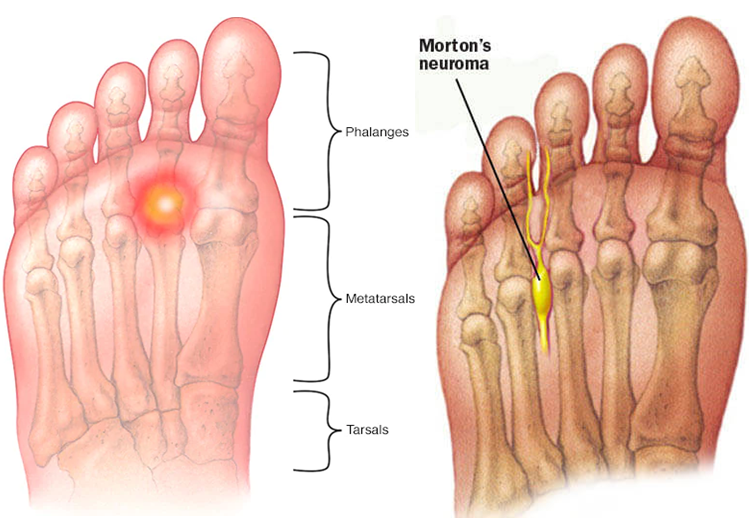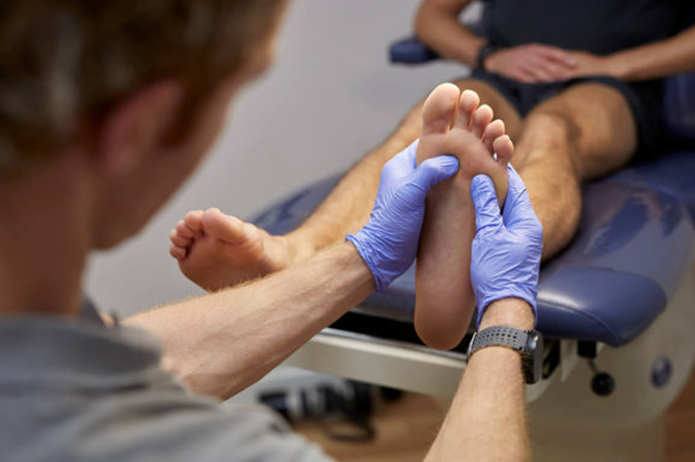
OVERVIEW OF MORTON’S NEUROMA
HOW TO TREAT PAIN IN THE FOREFOOT AREA IN MANCHESTER CITY IN A CONSERVATIVE WAY ALONGSIDE MORTON’S NEUROMA TREATMENT IN ORDER TO LIVE AND RUN PAINLESS
Do you suffer from forefoot discomfort? Have you ever thought it might be as consequence of Morton’s Neuroma?
This is what you need to know about Morton’s Neuroma. At My Sports Injury Clinic in Manchester City Centre, you will be given an accurate explanation on every aspect you might be concerned on, this condition is also known as interdigital neuroma, Morton metatarsalgia, plantar neuroma, Morton entrapment, interdigital nerve compression syndrome or benign tumor of the nerve, brings about when any of the nerves that are between the toes and that are responsible for providing sensitivity, grow into inflamed as a result of pressure continued (Adams WR 2nd, 2010).
The thickening of the nerve induces pain in the ball of the foot, causing electric shocks, a sensation of numbness and/or loss of sensitivity in the fingers. It’s said by a research study that this affection is not an actual neuroma. It is fibrosis of the nerve, though. (Maneesh Bhatia et la, 2020). This is due to the mentioned condition is deemed like a degenerative one instead of neoplastic. (Samer Morgan et la, 2021).

WHERE IS THE FOREFOOT PAIN EXACTLY LOCATED DUE TO MORTON’S NEUROMA?
Morton’s neuroma is frequently and chiefly found over the 2nd and 3rd metatarsals, this is viewed from an anatomical reference. When it comes to terms of the foot’s function, this is described as a zone where a major role is played by mimicking a tripod, it is also set out that a balanced foot ought to have three principal points of intense and constant impact absorption those are the 1st and the 5th metatarsals, and the heel. (Nikolaos Gougoulias et la, 2019).

In this instance, it is usually located between the 3rd and 4th metatarsals (75% of cases), although it can sometimes occur between the 2nd and 3rd (17% of cases). It very rarely occurs in other positions.
IS MORTON’S NEUROMA THE SAME AS METATARSALGIA?
According to an investigation by the National Health Service (NHS) it is highlighted that metatarsalgia mostly refers to a pain that takes place over the ball of the foot. Whereas, one of the sources of metatarsalgia might be the Morton’s neuroma condition, so, fundamentally it is entailed as a cause. Moreover, other differences can be the symptoms and signs, (K K Wu, 2000). Let’s dive into it below.
WHAT ARE THE MORTON’S NEUROMA SYMPTOMS?
The Symptoms of Morton’s Neuroma can be normally described as lack of outward signs, such as a lump or swelling. Also, there is intense, electrical pain between the bones of the foot that radiates to the toes. Specifically, tingling in the space between the 3rd and 4th toe. In addition, there is presence of cramps in the toes. Furthermore, the pain can increase when wearing narrow shoes or shoes that compress the foot and, in the case of women, high-heeled shoes. Usually, the forefoot pain gets worse over time, and pain at night is very odd.

If you regularly wear high-heeled shoes and got pain in the forefoot region you must take heed very carefully to this situation and should take into consideration to seek out professional help like the one that is provided by our knowledgeable sports physios in Manchester full of competence at our sports massage clinic in Manchester, since this ailment can be derived from many sources, so, it is of the utmost importance to attend to certified health care providers.
WHERE IS MORE COMMON TO SEE MORTON’S NEUROMA, IN FEMALE OR MALE?
Morton’s neuroma is more common in women than in men and usually occurs in the nerve that passes between the third and fourth metatarsals. It is a fairly frequent disease, its incidence in women is 6 to 18 times higher than in men and can occur at any age.
As reported by a publication on the National Library of Medicine website (NIH) the Morton’s neuroma showed a high incidence in the United Kingdom where as much as 87 females out of 100,000 got a confirmed diagnosis of plantar neuroma and the same observation in males accounted for 50 out of 100,00 (Michael David Post et la, 2020). Being this a corroboration to list this kind of neuroma as 2nd on the leaderboard of the most common compressive neuropathy, just left behind by carpal tunnel syndrome.
WILL MORTON’S NEUROMA EVER GO AWAY BEING TREATED AT THE SPORTS INJURIES CLINIC IN MANCHESTER?
HOW DO YOU FIX MORTON’S NEUROMA WITHOUT SURGERY? YOU MUST FOLLOW A PHYSIOTHERAPEUTIC TREATMENT IN THE PODIATRIC CLINIC IN MANCHESTER
WHAT ARE THE MORTON’S NEUROMA CAUSES AND WHY DOES IT OCCUR?
The causes of Morton’s Neuroma are essentially poor foot support when walking or playing sports, which increases pressure in the area. The use of high-heeled shoes, which increases the pressure on the interdigital nerves, as well as the use of narrow shoes. Due to direct trauma to the sole of the foot. Deformities of the hammer or claw toes, and other deformities such as bunions.
Some activities such as running, walking or ballet dancing increase the dorsiflexion of the fingers and the overload in the area. This indicates that mechanical overload has a direct impact on Neuroma.
CAN YOU GO RUNNING WITH MORTON’S NEUROMA?
HOW CAN MORTON’S NEUROMA BE DIAGNOSED? IS MORTON’S NEUROMA A SYMPTOMATIC DISEASE?
The Morton’s neuroma test is based on symptoms and medical examination of the foot, and confirmed by MRI or ultrasound showing thickening of the interdigital nerves (Jacob H Reisner et la, 2021).
From the clinical point of view, in 30% of cases Morton’s neuroma no abnormalities are observed. Squeezing the metatarsal heads with one hand while applying pressure to the plantar and dorsal interspace with the other hand often causes severe pain. Pain on transverse pressure of the forefoot (Mulder’s sign) also occurs. Sometimes, pressing the metatarsal heads produces a “click” caused by the movement of the neuroma dorsally.

Sometimes Morton’s Neuroma is confused with metatarsalgia of mechanical origin (overload), so it is necessary to perform some radio diagnostic tests to confirm its existence.
The diagnostic tests used for Morton’s Neuroma are ultrasound and magnetic resonance imaging, not being visible on a normal radiograph.
Our aim as a sports injury clinic in Manchester is to provide qualified, specialised and holistic physiotherapeutic treatment methods led by our top-notch physiotherapist specialists around Manchester, endeavoring to bring our clients back their pain free lives in a professional and quick way by taking into account the recovery timeframes.
WHAT IS THE TREATMENT FOR MORTON’S NEUROMA?
In 80% of the cases, we can solve the problem with conservative treatment without resorting to surgery. Initially the Morton’s Neuroma treatment consists of, biomechanical Study of the Gait; this is a clinical exploration by which we analyse the position of the feet in static and in movement, as well as the behavior of the knees, hips and spine. This allows us as physiotherapist and podiatrist in Manchester to identify and treat the biomechanical causes that produce alterations. This test allows us to know if there are biomechanical imbalances in the musculoskeletal system that can cause injuries in the medium/long term, as well as helping us to choose one type of footwear or another according to our way of walking.
Personalised Insoles, thanks to the biomechanical study of gait, it allows us to make personalised plantar supports aimed at eliminating overload and compression on the affected nerve.
Physiotherapy in the Sports Injuries Clinic in Manchester for neuropathies aimed at reducing inflammation in the area, which most of the cases turns out not to yield the expected outcomes, as there is low to none evidence according to literature and research studies, this is why it has said that surgery may be imperative to address this condition (Thomson CE et la, 2004).
Infiltrations, this will merely depend on the clinic and the evolution, we can resort to one or two injections of corticosteroids and anesthetics to accelerate the process of nerve inflammation.
Radiofrequency treatment (electric neurolysis) that allows, with local anesthesia and only a puncture, to reduce the neuroma, making the patient’s symptoms disappear. Radiofrequency energy is used to disrupt nerve function. It has the drawback that they have a higher rate of recurrence, so it must be repeated on occasion. However, in its favor is the fact that it does not leave a scar and has no adverse effects.
Surgery, If the previous treatments do not resolve the symptoms in a clear and effective way and in neuromas greater than 8 mm in diameter, surgery will be objectively recommended.
REFERENCES
Bhatia M, Thomson L. Morton’s neuroma – Current concepts review. J Clin Orthop Trauma. 2020 May-Jun;11(3):406-409. doi: 10.1016/j.jcot.2020.03.024. Epub 2020 Apr 10. PMID: 32405199; PMCID: PMC7211826.
Munir U, Tafti D, Morgan S. Morton Neuroma. [Updated 2022 Feb 5]. In: StatPearls [Internet]. Treasure Island (FL): StatPearls Publishing; 2022 Jan-. Available from: https://www.ncbi.nlm.nih.gov/books/NBK470249/
Gougoulias N, Lampridis V, Sakellariou A. Morton’s interdigital neuroma: instructional review. EFORT Open Rev. 2019 Jan 23;4(1):14-24. doi: 10.1302/2058-5241.4.180025. PMID: 30800476; PMCID: PMC6362341.
Wu KK. Morton neuroma and metatarsalgia. Curr Opin Rheumatol. 2000 Mar;12(2):131-42. doi: 10.1097/00002281-200003000-00007. PMID: 10751016.
Bencardino J, Rosenberg ZS, Beltran J, Liu X, Marty-Delfaut E. Morton’s neuroma: is it always symptomatic? AJR Am J Roentgenol. 2000 Sep;175(3):649-53. doi: 10.2214/ajr.175.3.1750649. PMID: 10954445.
Adams WR 2nd. Morton’s neuroma. Clin Podiatr Med Surg. 2010 Oct;27(4):535-45. doi: 10.1016/j.cpm.2010.06.004. PMID: 20934103.
Reisner JH, Boettcher BJ, Johnson AC, Cummings NM, Jelsing EJ. To Be or Not to Be (A Morton’s/Interdigital Neuroma): That Is the Question-A Case Series of Lateral Forefoot Pain Localized to the Proper Digital Nerve of the Fifth Toe. Clin J Sport Med. 2021 Sep 1;31(5):e287-e289. doi: 10.1097/JSM.0000000000000796. PMID: 32058453.
Thomson CE, Gibson JNA, Martin D.. Interventions for the treatment of Morton’s neuroma. Cochrane Database Syst Rev. 2004;(3). Art. No.: CD003118
